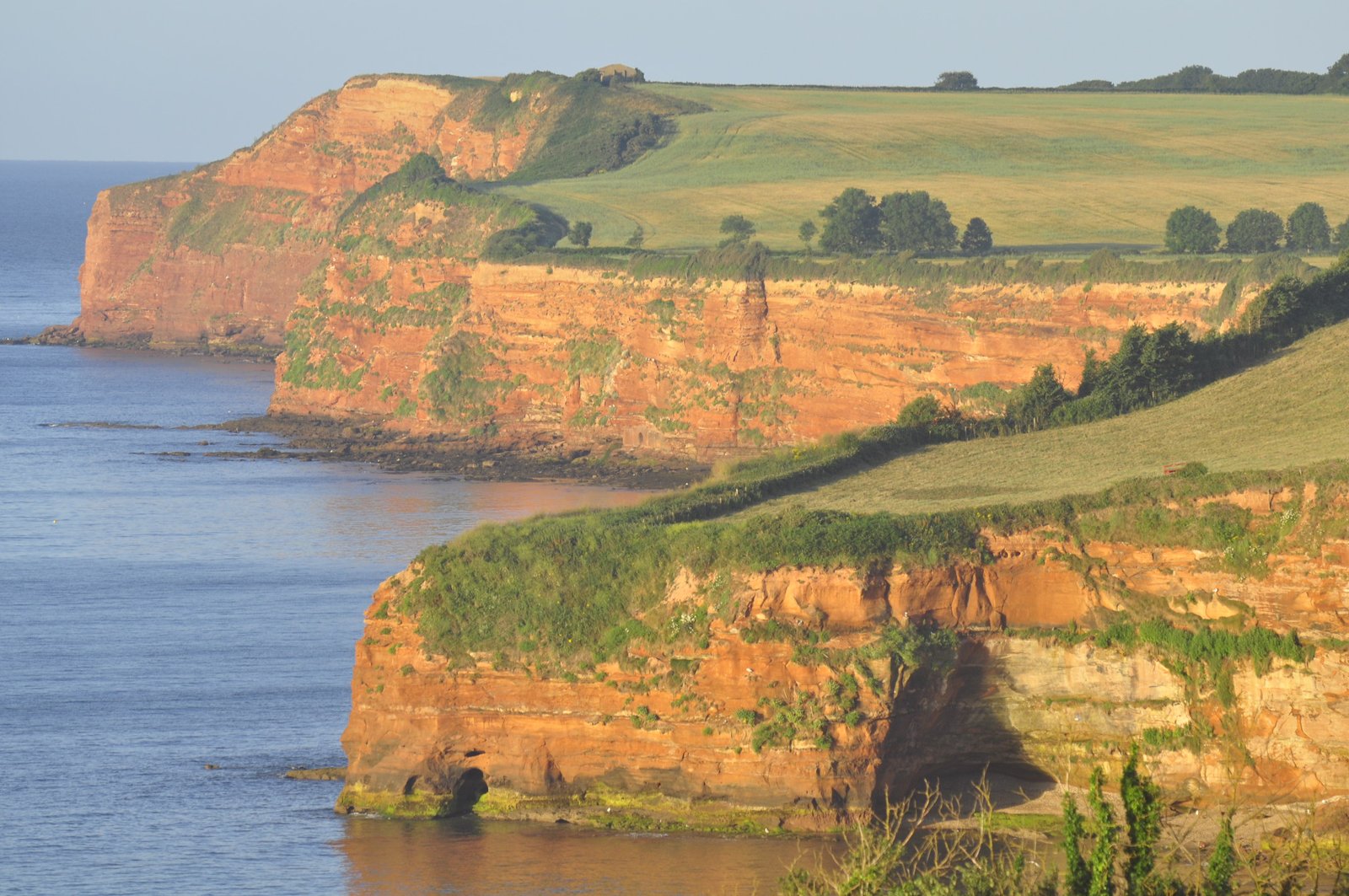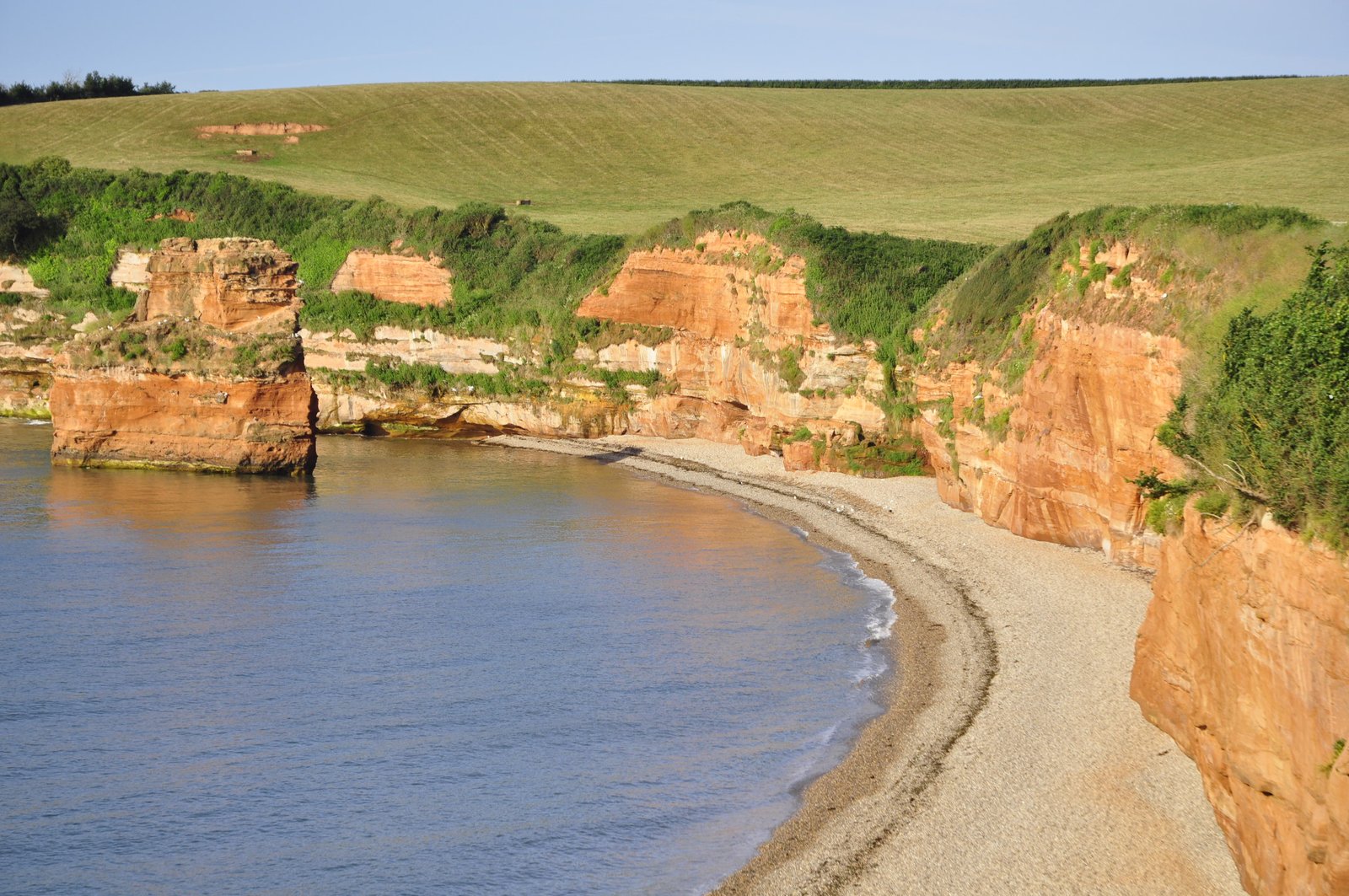I stand on the edge of the cliff. Below me, the sea, and the eternal sound of breaking waves and screaming seagulls, riding the air, mocking my fear of stepping too far out. The sun has just climbed above the hills in the east, sending the first warm rays onto the cliffs, making them orange-red like a poisonous drink on top of a good spaghetti sauce at sunset. The cliffs rise as pillars that look like they float on the sea.
A piece of Pandora in England? Or God just did a really artistic brick job? I wish, but these pillars have a far more interesting history.
Have a look at Go by bike – the best way to see the Channel Coast!
The place is Ladram Bay, Devon, English Channel Coast. Famous for its good climate, this piece of the English Riviera is a high quality tourist resort, with permanently parked cabin wagons, restaurant, night club and a few tent pitches for us lower budget travelers (at £40 per night for a tent, we expected wi-fi to be included). Rolling, classic English countryside hills surround Ladram Bay, before cliffs plunge into the sea.
Around 245 to 235 million years ago, it looked quite different. The time was the Early Triassic, and the Earth had revovered after the big mass extinction at the end of the Permian. With many spaces free after the extinction, evolution went into overdrive and started the Mesozoic, the age of reptiles – and the dinosaurs. England was far from the sea, somewhere inside the supercontinent Pangaea, which had just started in earnest to tear apart much further south.
England in the Early Triassic was around 15 degrees north of equator and a more or less a desert, where the wind blew eolian dunes in the sand. Rivers with fish appeared during floods and wetter periods, and reptiles and amphibians lived by their banks. Some of the reptiles, called Rhynchosaurs, became ancestors to mammals – and therefore to us.
Fast forward. More sediments piled onto Ladram Bay through the ages, sea levels rose and fell, ice ages game and went, and faults ocassionally sliced through the Triassic sediments. Finally, the English Channel broke through and started to erode the coastline of south England. Erosion follows zones of weaknesses, in this case the faults, and carved out narrow bays, until remnants of the sandstone stood, left behind as the huge pillars. Locals call them sea stacks, and because the sea erodes them harder at the base, they look like they float on the sea.
The red colour comes from tiny amounts of oxidized iron – rust – which form in rocks exposed to air, as these eolian and fluvial – geo-speak for desert and river rocks – were. Now and then fossils of the rhychosaurs, amphibians and fish erode out from the rock, and provide a glimpse of life 245 million years ago. Further East, in Dorset, the Otter sandstone, as this layer is called, is also a reservoir in the Wytch Farm oil field, the largest onshore in the UK.
Check out the mining heritage of Cornwall!
If you take a walk on the beach in Ladram Bay, you will see features from the desert and rivers long time ago. The layers are typically meter-thick, and show prominent cross-bedding, internal thin, dipping beds that build forward. Cross beds form in the wind shadow of dunes in deserts; wind grabs sand grains on the windward side, carries them across the dune, and then they drop on the silent lee side. The cross beds’ dip direction is this also the wind direction back then. Since wind directions and force change, cross beds also change directions, and eat into each other. The same phenomenon also occurs in water, where the cross beds point the direction of the currents or rivers. And, in between, are layers of old soils, from times when the wind carried fine particles from long away, or rivers flooded and left behind lots of mud. Now and then, Rhyncosaurs and other fossils erode out from the cliffs.
The beach itself consists of pebbles. Free back massage, and a good thing if you do not like sand in your shoes/clothes/hair/food/drinks – but you must wait for the next episode for their story!
In the mean time, enjoy the sunset, families having a good time searching for treasures on low tide – guarded by the local Seagull On Duty!
Have you been to Ladram Bay? Found any fossils or gotten pebbles in your shoes? Share your thoughts below! :)










Pingback: Why pebble beaches are the best – and how to make one | Adventures in geology - Karsten Eig·
Pingback: How to make oil in a few easy steps | Adventures in geology - Karsten Eig·